100+ Surprising Customer Service Statistics and Trends for 2024
After a decade of running WordPress businesses, we thought we knew everything about customer service. Turns out, we’re still learning!
Did you know you could lose half your customers from bad service alone? That’s just one of the mind-blowing customer service statistics and trends we’ve uncovered.
The world of customer service is changing fast, and these stats tell the real story. We’ve dug deep to find the most surprising trends that could reshape how you do business. From AI chatbots to social media support, we’re breaking down what really matters for your customers.
Ready to transform your customer service? Dive in and discover how to turn these customer service stats into real wins.

The Latest Customer Service Statistics and Trends
- The State of Customer Service
- Customer Expectations: What Matters Most
- Trends in Customer Service Technology and Tools
- The Growing Impact of Self-Service Support
- How Live Chats Are Transforming Customer Interactions
- AI's Role in Optimizing Customer Experiences
- Why Voice Support Still Matters
- Social Media and Customer Service
- Data Security: A Customer Service Priority
- Key Challenges and Metrics in the Customer Service Industry
The State of Customer Service
The world of customer service is constantly evolving. Let’s dive into some eye-opening customer service statistics that reveal the current state of the industry.
1. 43% of customers stopped buying from a brand in the past year due to poor customer service.
This shows how important good customer service is for keeping customers loyal.
Poor service can have serious consequences for businesses. In today’s connected world, unhappy customers often share their bad experiences online. This can deter potential new customers and hurt the brand’s image.
2. According to 36% of customers, retail has the worst digital customer service.
Retail shops like online boutiques face unique challenges in digital customer service. They often deal with high volumes of inquiries about products, shipping, and returns. That’s why balancing fast responses with personalized service can be tricky.
A good way to improve is to use a help desk tool like Help Scout, which is what we use at WPBeginner and our other partner brands.

It comes with live chat, a shared inbox, and a help desk. This lets you answer questions faster and keep track of all customer issues in one place.
3. Customers prefer calls (87%) and emails (86%) over contact forms (44%) and chat (43%) for reaching out to businesses.
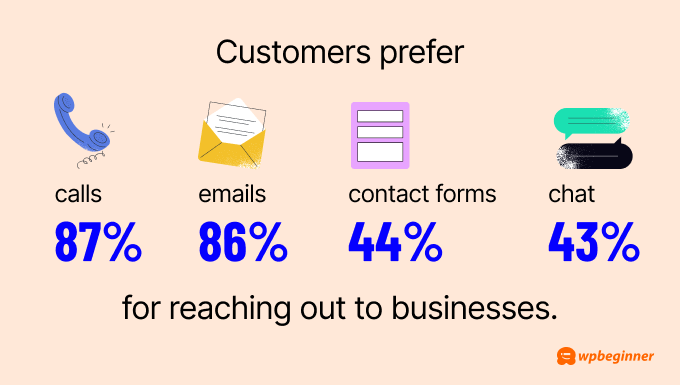
People like calls and emails because they’re familiar and feel more personal. Calls offer instant answers, while emails give a record of the conversation. Many customers trust these methods more than newer options like chat.
If you want to improve your phone support, then consider using Nextiva. It’s a great business phone service that we use here at WPBeginner and our other partner brands.
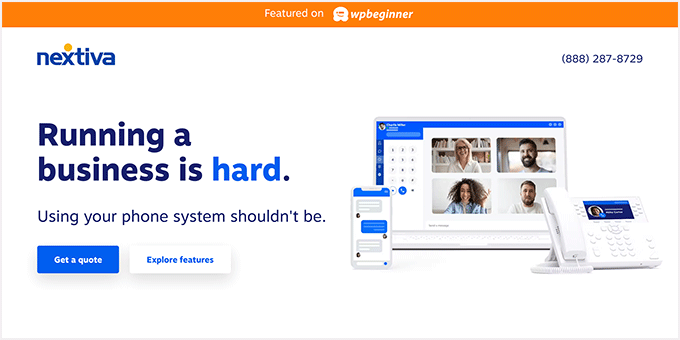
When you sign up, you get both a toll-free and a local number. Your team can use the Nextiva app on computers or phones to handle calls.
Nextiva works with all kinds of phones, from desk phones to conference systems. It’s all cloud-based, so it’s easy to set up and use. You can learn more about it in our Nextiva review.
More General Customer Service Statistics
- 74% of customers have experienced a product or service problem in the past year.
- 79% of customers will make the time and effort to complain about an issue.
- 29% of customers say they would complain to a company after one negative experience.
- 27% of customers rarely complain to a company after a negative experience.
- 33% of customers leave a brand after two negative experiences. The most common customer problems are related to product pricing and performance quality.
Customer Expectations: What Matters Most
Now, let’s look at what customers really want from their service experiences.
4. 45% of customers expect their issue to be solved the first time they contact a company.
In other words, people don’t want to repeat their problems to multiple agents. Instead, they hope for quick, effective solutions without having to call or email again. This shows how important it is to train your support team well.
One way to improve first-contact resolution is to use a good knowledge base platform. This tool can help your team find answers quickly and let customers find solutions on their own. With a well-organized knowledge base, you can solve more issues on the first try.
If you use WordPress, then HeroThemes is a great support plugin bundle for this. It comes with the Heroic KB plugin that adds a searchable knowledge base to your site. You will also get Heroic Inbox to manage all your customer emails and support tickets in one place.
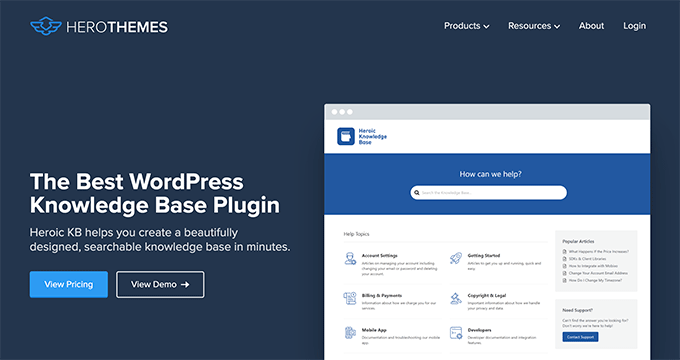
For more information, check out our HeroThemes review.
5. When customers reach out for support, 36% want a refund, 27% want the product fixed, 25% want an explanation, and 24% want an apology.
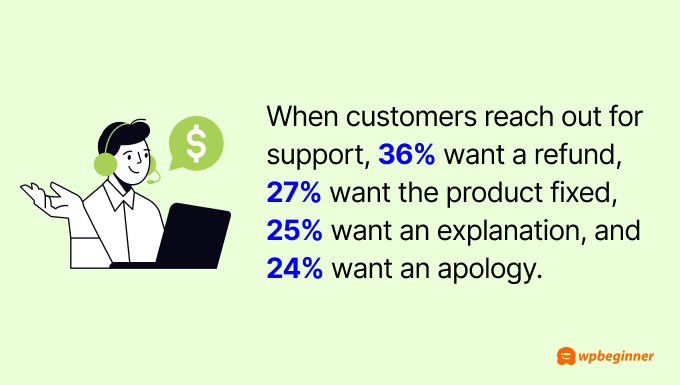
These customer service statistics show that people expect different solutions when things go wrong. To meet these expectations, it’s important to have flexible policies in place.
A clear money-back guarantee can help satisfy the largest group of unhappy customers. For example, our partner brand OptinMonster offers a 14-day money-back policy if the user doesn’t see any improvement in their lead-generation efforts.
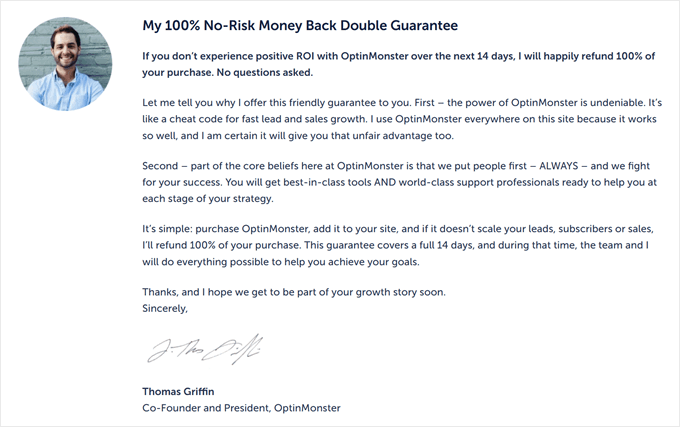
For products that can be repaired, offering a repair service or replacement can be a great option.
To improve customer service experiences, create guidelines for your team on how to respond to issues. Train them to explain problems clearly and apologize sincerely. This approach can help turn bad customer service situations into positive ones, building trust and loyalty.
6. The top 2 things customers get most frustrated by are long waits and hard-to-find contact details when they need help.
To improve customer service, set clear expectations about when you’ll respond.
For example, you will want to tell users your business support hours and time zone. This helps them know when to expect help. You can add this info to your website’s contact page or in auto-replies to emails.
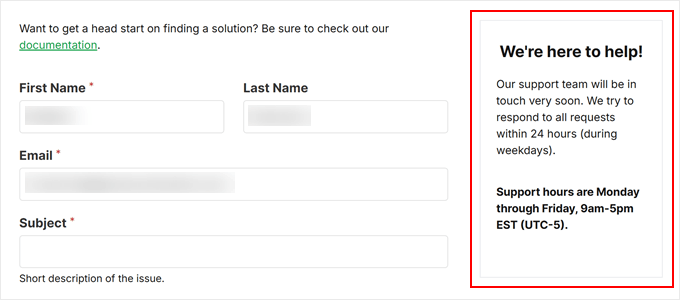
For clearer contact info, adding a clear ‘Contact Us’ link in your main menu should be enough. Or consider adding a floating contact form to your website or using a slide-out form that’s always visible.
These customer service strategies can make it easier for people to reach you when they need help.
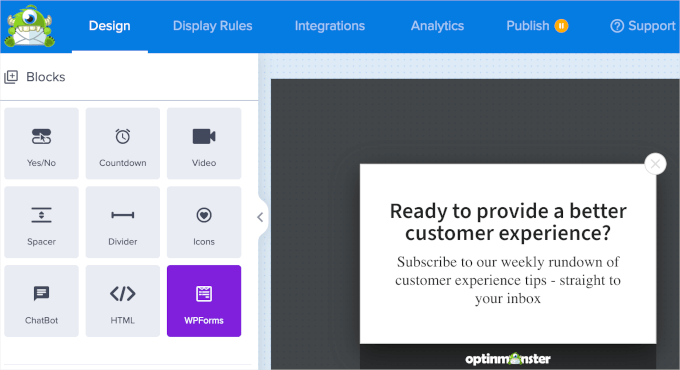
7. 1 in 4 customers don’t complain because they think nothing can be done about their problem.
This finding reveals a lack of confidence in many businesses’ ability to solve issues. Even if these customers don’t complain, they might leave for a competitor at any time. This silent dissatisfaction can be a hidden threat to your business.
To boost customer confidence and improve service experiences, try being proactive. One effective strategy is to set up a follow-up email after each purchase. This shows customers you care about their experience and are ready to help if needed.
You can use a tool like FunnelKit to create these follow-up email sequences easily. For example, you can ask for feedback, offer help, or simply thank them for their purchase. This proactive approach to customer service can catch problems early and show customers you’re committed to their satisfaction.

More Facts About Customer Expectations
- 87% of support teams say customer service expectations have increased in the past year.
- 80% of customers have complained about their most serious problem.
- 69% of customers want more than just monetary compensation for a complaint.
- 67% of customers expect ticket resolution within 3 hours.
- Customers prioritize response speed (63%), resolution speed (57%), knowledge (49%), availability (49%), and empathy (43%).
- 53% say poor self-service happens when it’s too hard to talk to a real person, while 46% cite conflicting information from support agents.
- 50% of complaints were made digitally.
- 48% of customers did not get a response from complaining.
- Besides first-contact resolution, customers care about resolution time (25%) and personalized service (22%).
- Only 8% of customers want to solve problems through self-service.
Trends in Customer Service Technology and Tools
Here are the latest trends in customer service technology that are shaping the industry.
8. 43% of companies use email tools, 41% use CRM systems, 40% use live chat, 36% use help desks, and 33% use feedback surveys for their customer service.
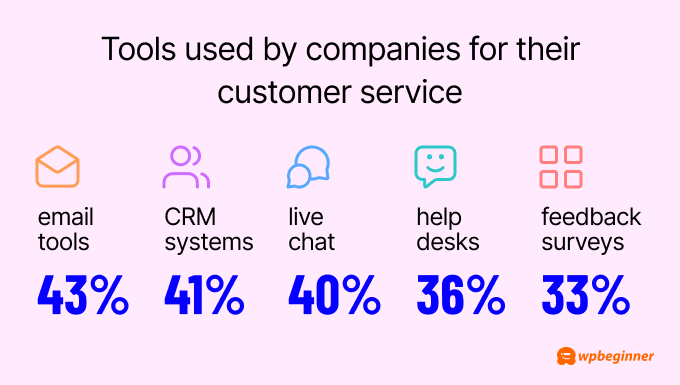
Many businesses now use multiple tools to create an omnichannel customer experience. This approach lets customers reach out through their preferred method.
For example, a customer might start a conversation via live chat on your website. Later, they could follow up by email.
Your team could then use a CRM system to track this interaction history. If needed, they might send a feedback survey after resolving the issue.
This seamless experience across different channels can lead to higher customer satisfaction.
9. 64% of customer service agents say having a single view of a customer’s interactions across all channels can help them work better.
With a single view of customer interactions, agents can see all past conversations, no matter how the customer reached out. This means they don’t have to ask customers to repeat information, which can be frustrating.
If you want one tool that does it all, we recommend HubSpot. This platform comes with a CRM tool, shared inbox, live chat, a ticket system, and more. You can read more about its features in our HubSpot review.
Even if you prefer separate tools, make sure they work well together. For WordPress users, Uncanny Automator can help connect different tools.
For example, if someone fills out a WPForms contact form, Uncanny Automator can save their information and send it to your CRM app. This keeps all customer data in one place, helping your team provide better, more personalized service.

More Tech-Based Customer Service Statistics
- 75% of support departments say they want tools that can eliminate manual tasks like routing and tagging tickets.
- 74% of leaders say switching between tools makes ticket resolution take longer.
- 62% of agents say access to data for personalizing interactions would help them work better.
- 56% of agents want easier tools to do their job better.
- 35% of companies look for new tools due to cost concerns.
- 32% search for new tools because of data security worries.
- 29% seek new tools because of platform downtime issues.
- 28% want new tools for better real-time insights.
- 28% look for new tools due to integration complexity.
The Growing Impact of Self-Service Support
Self-service support, such as knowledge bases, is changing how businesses help customers. Here are some eye-opening statistics about this trend.
10. Businesses that use knowledge bases get 23% fewer customer support tickets.
Knowledge bases let customers find answers on their own. This means they don’t need to contact support as often. Happy customers can quickly solve simple problems, while support teams can focus on more complex issues.
If you use Heroic KB as your knowledge base software, then you can get built-in analytics showing you what customers are looking for and how they use your help articles. You can then use this information to improve your guides and save more time for your support team.
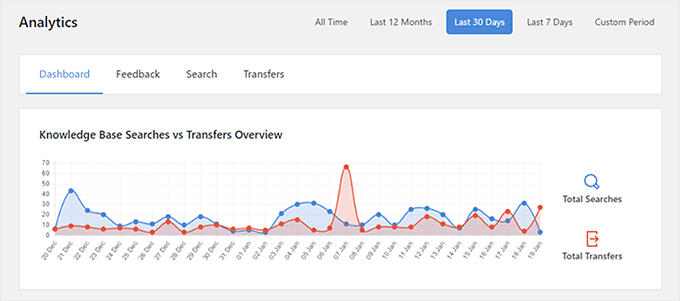
11. 50% of users think seeing answers right in search results, not just links, makes a business’ self-service portal better.
This makes sense because they don’t have to click through multiple pages to find what they need. Instead, they get the answer right away. This quick access to information can make customers happier and more likely to use self-service options.
Heroic KB can help with this. It has an AJAX search feature that shows answers as soon as people start typing in the search box. This means your visitors can get help quickly, without waiting for you or your team to respond.

12. 9 out of 10 Millennials look for answers online before calling customer service.
Millennials prefer solving problems on their own first because they’re used to finding information quickly online. It’s often faster and more convenient than waiting on hold or explaining an issue to a support agent.
To make sure these customers find your help articles, we recommend using a tool like All in One SEO (AIOSEO). This plugin helps you optimize your knowledge base content for search engines.
You can easily add meta titles and descriptions, create a sitemap automatically, connect your website to webmaster tools like Google Search Console, and more. Doing all these things helps search engines find and show your help articles in relevant search engine results pages.
Another helpful tool is SEOBoost. It gives tips on how to improve your content by suggesting keywords to use, how long your articles should be, what questions to answer, and so on. This can help make your help articles much more relevant to your users’ needs.

More Self-Service Stats and Findings
- 91% of people would use a knowledge base if it met their needs.
- 40% of call center volume can be reduced by using a knowledge base.
- 39% of businesses plan to invest in customer portals.
- 34% of leaders think their self-service options don’t meet customer expectations.
- Self-service interactions can cost just $0.10, compared to $12 for live support.
- Knowledge bases can improve first-contact resolution by 26%.
- 44% of customers want advanced filtering in self-service tools.
- 43% of users want to search for help within the product itself.
- For self-service portals, 33% of customers want recommendations based on what helped others with similar problems.
How Live Chats Are Transforming Customer Interactions
Live chat has allowed customers to talk directly with businesses online Here are some interesting facts about live chat support.
13. 8 out of 10 customers expect chat agents to help with everything, including sales and tech support.
This means customers want to do more than just get help—they want to buy things, too. As a business owner, you should consider adding sales features to your chat system.
If you want to sell through chat, try using LiveChat. It’s what we use on our WPBeginner Pro Services pages to communicate with potential customers.
This tool works with PayPal, so you can take payments right in the chat window. LiveChat also connects with Mollie, which lets your team set up subscriptions, handle one-time sales, and quickly check order details within the chat.
We talk more about the platform in our LiveChat review.
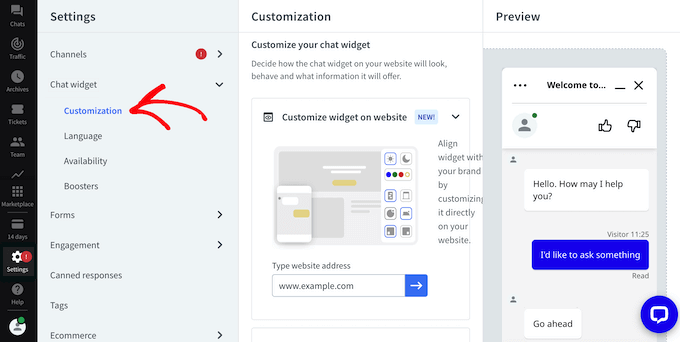
14. Most live chat issues are fixed in 42 seconds.
This is a good goal, but don’t rush your team. Quick responses are great, but getting the right answer is more important.
To answer quickly, you can save answers to common questions as canned responses. With LiveChat, you can do this with just one click. These canned responses can be just for you or shared with your whole team.

For example, if customers often ask about shipping times, you could save a friendly response explaining your delivery process.
15. Live chat can make businesses 48% more money per chat hour and increase sales by 40%.

You can use live chat to suggest related products, but be careful not to push too hard. For example, if someone’s buying a phone, you could kindly ask if they need a case or screen protector, too.
You might say, “Thanks for choosing our phone! Many customers also get a case to protect it. Would you like to see some options that match your new phone?” This gentle approach can increase sales without feeling pushy.
16. 29% of customers don’t like when chat responses sound too scripted.
This means people want chats to feel natural, not like talking to a robot. We recommend training your team to be friendly and use their own words. Let them add a personal touch to make each chat feel more real.
And instead of using one strict script, prepare multiple templates for common situations. Then, encourage your team to adapt these templates to each conversation.
For instance, you could offer several different ways to greet customers or ask for more information. This variety helps chats feel more natural and personalized.
If you need help, AI tools like OpenAI can help you rewrite your messages in various tones or styles. This can give your team more options to choose from, making their responses feel more natural and less scripted.
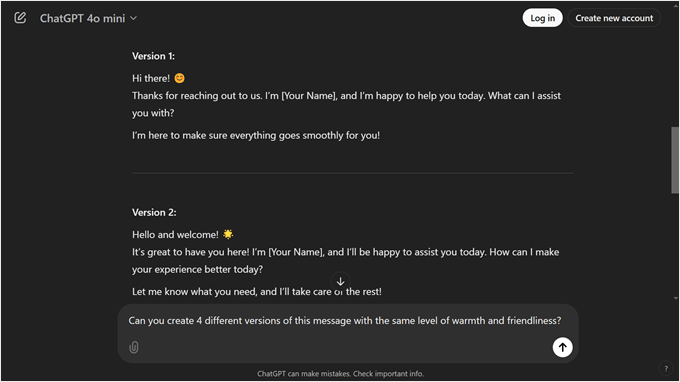
More Stats and Trends About Live Chat
- 95% of customers value high-quality support over quick responses in live chats.
- 95% of people prefer slower support if it means better help.
- 61% of B2B businesses offer live chat, compared to only 33% of B2C businesses.
- 55% of customer experience leaders feel they are behind in providing instant experiences.
- 38% of consumers are more likely to buy from a company that offers live chat support.
- Consumers say they have been able to buy things directly in chat conversations 34% of the time.
- 33% of businesses have implemented conversational commerce (buying and selling via live chat).
- 28% of customers leave chat queues before getting help.
- 20% of organizations can automatically identify customer intent in chats.
- Companies with over 90% satisfaction ratings have longer chats, averaging nearly 12 minutes.
AI’s Role in Optimizing Customer Experiences
AI tools like chatbots have greatly reshaped customer service. Here’s how AI is influencing customer experiences and trust.
17. 50% of customer service leaders say AI has helped them offer 24/7 support.
This is the main reason why AI chatbots are so popular. They can answer simple questions right away and handle many conversations at once at any time of the day, which is hard for human agents to do.
If you want to add a chatbot to your WordPress site, then we have a guide that can help. It shows you how to set up a chatbot using the Heroic KB plugin.
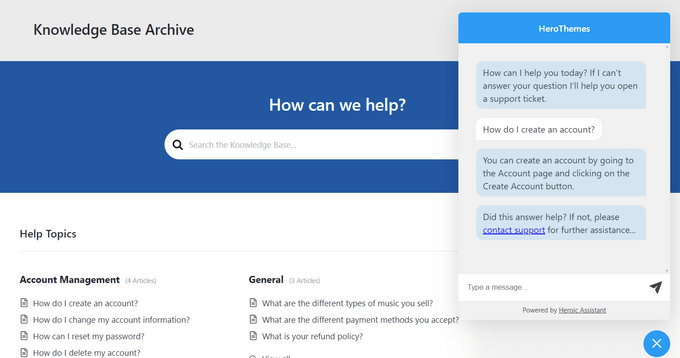
This chatbot is smart because it learns from your knowledge base articles. This means it can give accurate answers to visitor questions.
18. 65% of customers think bots are good at answering basic questions, but only 47% say bots are good at showing empathy when addressing concerns.
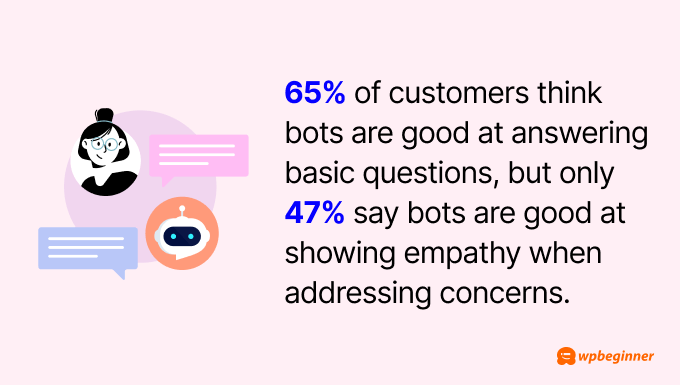
This means that while chatbots are helpful for simple tasks, they still struggle with more complex emotional situations. People often want to feel understood when they have a problem, and bots aren’t always great at this.
In this case, it’s good to use a chatbot tool that can connect with a live chat service, like ChatBot with LiveChat.
These tools are managed by the same company, so integrating them is easy. This way, when a customer needs more empathetic support, you can quickly hand off the conversation to a human agent.
Furthermore, with ChatBot, you can create different messages for users in various regions, countries, and time zones. This is great if you have customers from around the world or if your WordPress site is in multiple languages.
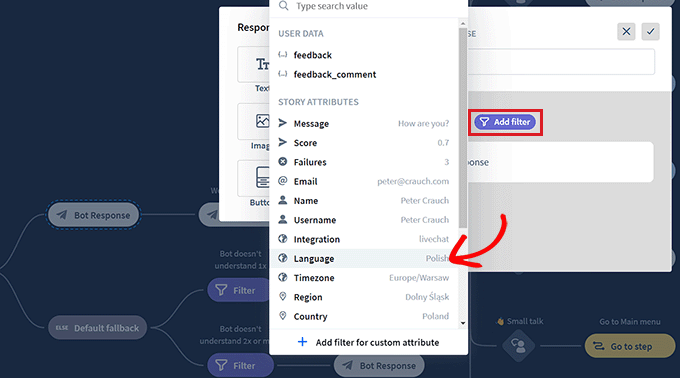
You can read more about the platform in our ChatBot review.
19. To trust AI more, customers want transparency about how it’s used (42%), human checks on AI outputs (35%), and more control over AI use (32%).
These numbers show that customers are open to AI, but they want to know what’s happening behind the scenes.
As a business owner, you can build trust by being clear about when and how you use AI.
A simple way to do this is to introduce your AI assistant upfront. For example, when a chat starts, you could say something like, “Hi, I’m X, [Company Name]’s AI assistant. I’m here to help, but a human team member can take over anytime if needed.”
This approach is similar to what Hostinger does with their AI chat.
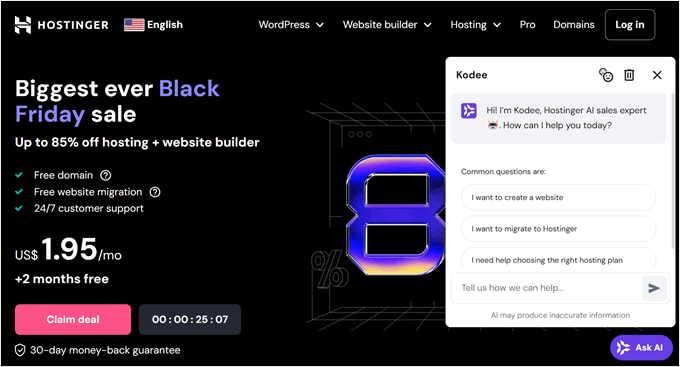
More Statistics About AI in Customer Service
- 72% of customers want to know when they’re talking to an AI agent.
- 59% of businesses say AI has reduced customer service costs, while 31% report increased costs.
- 48% of users find it hard to tell AI from humans in customer service.
- 45% say AI’s top benefit is time-saving, 44% say fast problem-solving, and 35% say cost efficiency.
- 40% of companies plan to invest in AI chatbots, making it the top choice for customer service tech.
- 40% of customers are comfortable with AI scheduling appointments.
- AI assists support teams by analyzing feedback (35%), suggesting knowledge base answers (34%), and expanding brief notes (28%).
- 25% of businesses expect AI to match human capabilities in 5-10 years.
- Only 1 in 10 customer experience leaders think their current chatbots are as good as human agents.
- Experts predict new AI-related jobs: AI customer support specialist (29%), chatbot analyst (42%), conversational UX mapper (32%), and conversation designer (26%).
Why Voice Support Still Matters
While digital channels are growing, voice support remains crucial in customer service. Let’s explore why.
20. 29% of consumers rate phone calls as the top choice for complex problems.
People often prefer talking on the phone for tricky issues because it’s easier to explain and get immediate responses. Voice calls allow for a more personal touch and can help resolve issues faster than back-and-forth emails or chats.
If you’re worried about the cost of phone support, then Nextiva offers a solution. They provide unlimited calls in the US and Canada, including toll-free minutes. You can even keep your current number with their porting service.
And since Nextiva uses VoIP technology, it’s often cheaper than traditional phone lines.
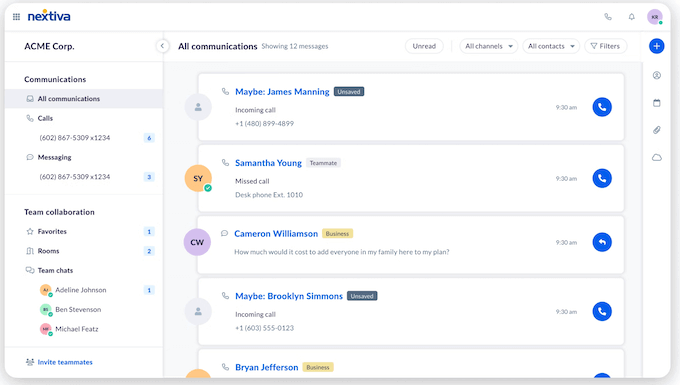
21. 60% of consumers say they’re often transferred to different agents or departments during calls.
This can frustrate customers and waste their time.
To avoid this, Nextiva offers an auto attendant feature. This lets callers choose the right department from the start, reducing the need for transfers. It can improve your service quality while making things easier for your support team.
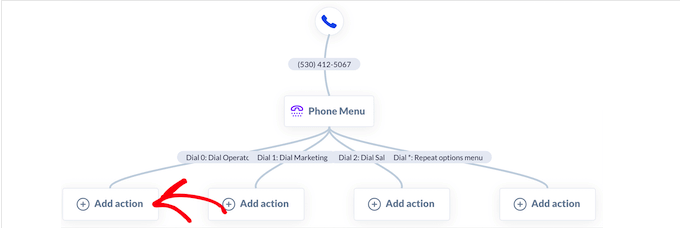
More Voice Customer Service Stats
- 71% of companies use digital customer service channels first but switch to phone calls for big problems.
- 65% of customers will hang up if the voice support quality sounds bad.
- 62% of customer service leaders who make good returns on investment from their tools focus on making phone support better.
- 57% of customer service experts think automated voice assistants will be a top customer service channel.
- People like using video for customer service 67% more than before.
- 36% of customers would rather talk to a real person on the phone, even if they have to wait.
Social Media and Customer Service
Social media has become a crucial platform for customer service. Here are some stats that show how customers use different social channels to interact with brands.
22. On X/Twitter, 20% of users complain to brands, while on Facebook, it’s 14%, and Instagram has the lowest at 8%.
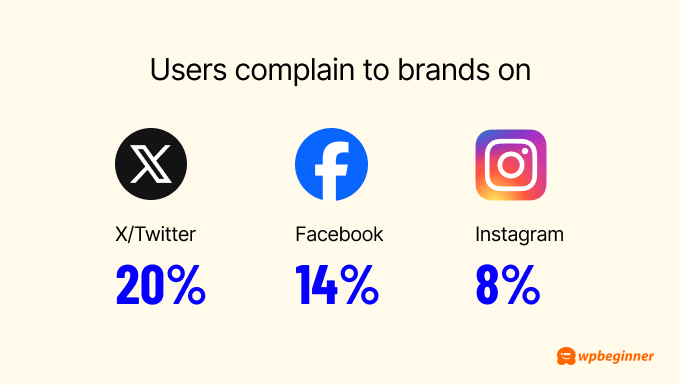
X/Twitter’s real-time nature makes it easy for quick complaints. Facebook is more for general feedback, while Instagram is mostly positive, with fewer complaints.
If you show user-generated posts on your website, be sure to filter out some of the negative content to avoid damaging your brand image. Smash Balloon plugins can help you do this, letting you display only positive customer feedback.
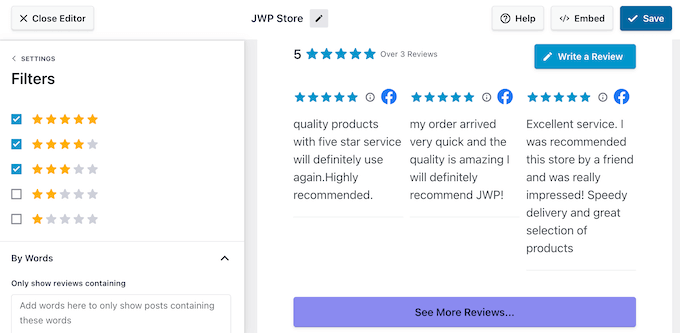
You can read our guide on how to add a social media feed in WordPress for step-by-step instructions.
23. Half of social media users expect brands to answer their complaints within 3 hours.
This quick response time is challenging but important.
To meet this expectation, consider having a dedicated social media support person. This way, someone is always ready to respond to customer issues on social platforms, and another person can just focus on social media marketing.
More Social Media in Customer Service Trends
- 54% of global consumers view brands more favorably when they respond to questions or complaints on social media.
- Consumers have shared personal product experiences on social media 41 times on average in the past year.
- 51% of people expect brands to respond to a negative review within 7 days.
- Handling customer service through social media can be 12 times cheaper than phone support and can boost customer support by up to 25%.
- Not responding to social media comments can make brands lose 15% more customers.
- Users expect quick responses to complaints: 33% on Instagram, 29% on X/Twitter, and 27% on Facebook want replies within an hour.
- If brands don’t respond quickly enough, about 30% of consumers across X/Twitter, Facebook, and Instagram will stop buying from them.
- Slow response times make up to 49% of social media users less receptive to a brand’s ads.
Data Security: A Customer Service Priority
Here are some eye-opening statistics about data protection in customer service.
24. 56% of customer service leaders say their company’s customer data was hit by a cyber attack or data breach in the past year.
Protecting customer data isn’t just about avoiding trouble – it’s about building trust and providing good service.
WordPress users can boost their security by choosing a secure host like SiteGround, which we use at WPBeginner. They have smart systems that block bad bots and attackers. SiteGround even has a special security tool that checks incoming malicious requests to protect customers from cyberattacks.
Installing security software is also a good idea. We use Cloudflare as our CDN (Content Delivery Network). It not only speeds up websites but also adds an extra layer of protection against DDoS attacks.
For even more security, consider using WPBeginner Pro Services for WordPress maintenance. We keep WordPress, themes, and plugins up to date, make regular backups, remove malware, and watch for any downtime. This full-service approach helps keep your site and customer data safe.
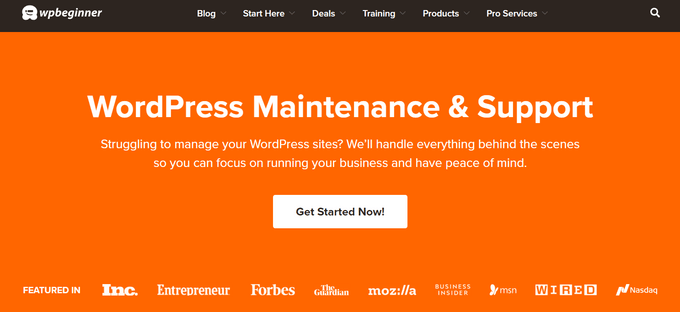
Feel free to book an appointment with our team to get more information.
25. 6 out of 10 customers think companies aren’t doing enough to protect their data.
This shows how important it is to make customers feel their information is safe with you. Building this confidence can set you apart from competitors and improve customer trust.
One way to boost security and show customers you care is by installing an SSL certificate. This not only protects data but also adds a padlock icon in the browser, making your site look more trustworthy.

You can also display security trust signals on your site.
For example, add security badges from well-known companies on your homepage and pricing page. On checkout pages, show logos of secure payment methods you use. These visual cues can help customers feel safer sharing their information with you.

More Findings About Customer Data Privacy
- 80% of customer experience leaders say customers might switch to more transparent brands if they don’t understand how their data is used.
- 75% of leaders are working with external partners to improve customer data privacy.
- 74% of leaders say they have comprehensive plans to fight digital deception and fraud in customer service.
- 70% of customers won’t buy from a company that they think has weak security.
- 78% of leaders believe not using encryption leaves customer data at risk.
- Only 28% of leaders say they have advanced knowledge to implement data privacy best practices.
Key Challenges and Metrics in the Customer Service Industry
The customer service industry faces several hurdles. This section will explore some of the biggest challenges and how to overcome them.
26. 40% of companies struggle to attract and keep good customer service staff.
Finding and keeping skilled customer service representatives is tough. Good agents need a mix of skills like patience, problem-solving, and clear communication. When these talented people leave, it can hurt the quality of service and customer trust.
If you need help finding quality customer service staff, then check out our list of the best freelance websites to hire talented customer service reps for your team.
27. Customer satisfaction (31%) and customer retention (31%) are the two main metrics customer service teams use to measure success.
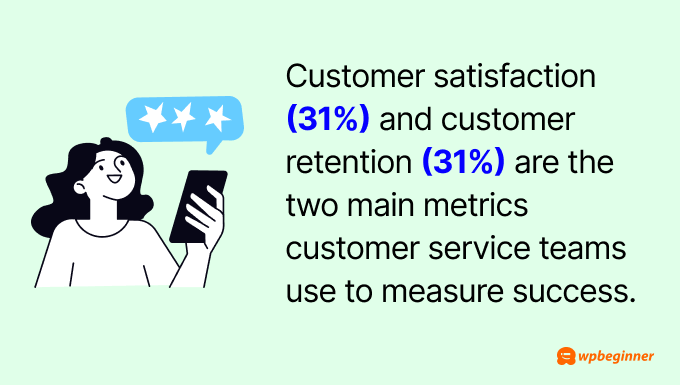
These customer service statistics highlight the industry’s main challenges: keeping customers happy and encouraging them to stay loyal. Happy customers are more likely to stick around, but measuring satisfaction accurately can be tricky.
A good way to boost both satisfaction and retention is to regularly ask for feedback. This helps you understand what customers like and where you can improve. It also shows customers that you value their opinions.
For WordPress users, the UserFeedback plugin is a great tool for gathering customer insights. It lets you create surveys and collect feedback directly on your website. This way, you can learn what your customers think and use that information to improve your service.
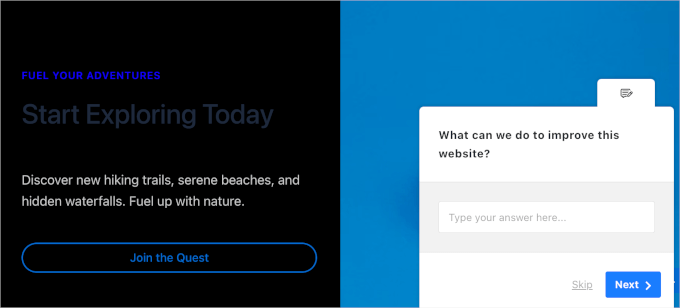
You can learn more about the plugin in our UserFeedback review.
More Customer Service Challenges and Success Trends
- 47% of customer service teams focus on making their work more efficient.
- 40% want to help customers solve problems on their own with self-serve tools.
- 38% use feedback forms to see how well they’re succeeding.
- 32% face find it difficult to manage their company’s conversation or call volume.
- 30% look at online reviews and ratings to measure success.
- 30% make follow-up calls or emails to check if customers are satisfied with their services.
Sources:
Salesforce, Zendesk, Intercom, Coveo, HubSpot, Customer Care Management & Consulting, Khoros, Ultimate.ai, Desku, G2.
We hope this list of customer service statistics and trends can help you optimize your own customer service strategy and satisfy more customers.
If you want to read more data-driven articles like this one, then check out the articles below:
Discover More Useful Statistics and Trends for Your Business
- Content Marketing Trends — What’s Hot and What’s Not
- Mindblowing SEO Statistics and Trends (Ultimate List)
- Blogging Statistics, Trends & Data – Ultimate List (UPDATED)
- Google Search Statistics and Data
- Impressive eCommerce Statistics You Won’t Believe
- Shopping Cart Abandonment Statistics (Expert Insights)
- Affiliate Marketing Statistics You Need to Know
- Nonprofit Marketing Statistics and Insights You Should Know
If you liked this article, then please subscribe to our YouTube Channel for WordPress video tutorials. You can also find us on Twitter and Facebook.
The post 100+ Surprising Customer Service Statistics and Trends for 2024 first appeared on WPBeginner.
این خبر را در ایران وب سازان مرجع وب و فناوری دنبال کنید
مشاهده پاسخ های این مطلب
———————————————
این مطلب از سایت انجمن وردپرس گردآوری شده است و کلیه حقوق مطلق به انجمن وردپرس می باشد در صورت مغایرت و یا بروز مشکل اطلاع دهید تا حذف گردد
منبع: انجمن وردپرس